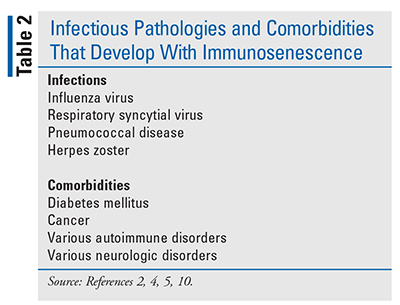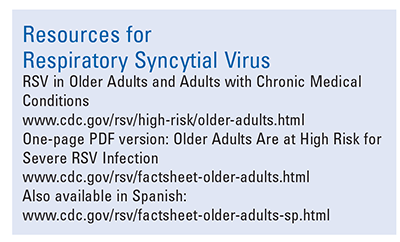US Pharm. 2020;45(10):10-12.
While advances in medical sciences and nutrition over the past 150 years have fostered a significant increase in life expectancy, immunosenescence (i.e., age-related dysregulation and decline of the immune system) has been associated with an increased susceptibility to infectious pathogens, the development of comorbidities, and poor vaccine responses in older adults.
Other than safe drinking water, vaccines have produced the greatest impact on reducing mortality from infectious diseases, such that their development and widespread use are among the greatest public health achievements of the 20th century.1 Pharmacists have an understanding of the significance of vaccines in public health, but it is certainly worth raising awareness of their importance as it relates to immunosenescence (i.e., age-related dysregulation and decline of the immune system) and their effectiveness in older adults. While advances in medical sciences and nutrition over the past 150 years have fostered a significant increase in life expectancy, immunosenescence has been associated with an increased susceptibility to infectious pathogens, the development of comorbidities, and poor vaccine responses in older adults.2,3 Particularly relevant and timely is the issue of vaccine development in this era of the COVID-19 pandemic.
Immunosenescence: General Concept
The onslaught of foreign organisms and pathogens that an individual encounters on a daily basis requires a functional immune system for continued survival.3 It is recognized, however, that the immune system in aging humans—and in many other species—undergoes a decline of various biological systems (TABLE 1), referred to as immunosenescence, which leads to a higher incidence of infections (TABLE 2) and numerous comorbidities, such as diabetes mellitus, cancer, and various autoimmune and neurologic disorders.4,5 Further, older adults experience a higher level of severity of viral and bacterial infections (e.g., influenza, respiratory syncytial virus [RSV, see RESOURCE], herpes zoster, pneumococcal disease) compared with younger individuals, resulting in the development of greater acute and long-term sequelae.6-9



Specifically with regard to many respiratory pathogens, including influenza viruses and RSVs, death rates for these conditions are also the highest among this older adult population.10 For example, for every 10,000 persons in the United States aged 18 to 49 years, only 0.4 people die from the annual flu; that number increases to 5.9 people per 10,000 for those between the ages of 65 and 74 years, and 47.5 people per 10,000 for those older than age 74 years.10
The effects of biological aging that cause a progressive decline in function of the immune system collectively result in diminished humoral and cellular immune responses.11-13 Though it still remains unclear what the precise role humoral immunity plays in protecting an individual from an infection such as RSV, according to Crooke and colleagues, it is apparent that age-related changes in both humoral and cellular immune responses may impact the progression of RSV infections in older adults.2 While it is difficult to discern if immune-cell dysregulation is a result of cellular changes or a reaction to changes somewhere else in the body, it is well documented that there are functional differences in the aging immune system.14,15 In this regard, several studies have reported negative clinical outcomes in individuals aged 65 years and older.2
Vaccines for Older Adults
Traditionally, vaccines have been preparations of killed or attenuated microorganisms that provide active immunity that enables an individual to fight a variety of viral and bacterial infections.16 There are some general principles regarding the use of vaccines in special populations. Examples include the avoidance of live viruses in significantly immunocompromised individuals (e.g., persons with cancer, HIV infection, and solid organ or bone marrow transplantation) and the CDC recommendation that all healthcare professionals receive an annual influenza vaccination—leading many healthcare facilities to mandate that employees receive an annual influenza vaccination or wear masks during influenza season.16,17
Although vaccination serves as the main strategy for preventing certain infections, primary vaccine responses are often lower in older adults.18-21 These diminished responses:
• Are predominantly linked to the function and perceived failure of the adaptive immune response
• Frequently fail to induce long-term protective immunity in these individuals
• Place older individuals at further risk for subsequent disease
An improved mechanistic understanding of changes in the immune system over time (i.e., through systems-level analyses and longitudinal studies) will provide insights into the biology of immunosenescence and facilitate the rational design of personalized vaccines for older adults.2
COVID-19 Vaccine Development: Issues to Consider
Operation Warp Speed: A press release from the U.S. Department of Health and Human Services, dated June 16, 2020, indicates that an important initiative, named Operation Warp Speed (OWS), aims to deliver 300 million doses of a safe, effective vaccine for COVID-19 by January 2021. This effort is part of a broader strategy to accelerate the development, manufacturing, and distribution of COVID-19 vaccines, therapeutics, and diagnostics that are collectively known as countermeasures.22 Pharmacists can find a fact sheet explaining OWS for patients in Reference 22.
Age as a Critical Variable: People aged 65 years and older suffer the most severe cases of COVID-19 and have the highest associated mortality rate. According to Bridle and Sharif, if the goal is to have COVID-19 vaccines ready for public use by early 2021, the only ones that have a chance are those currently in clinical trials. It is likely that most of these have not undergone preclinical optimization for an older adult population; therefore, these first-generation COVID-19 vaccines may not perform well in the individuals who require them most.10
While it is too late to address these considerations in the preclinical testing for the COVID-19 pandemic vaccine, these authors indicate that it is imperative for researchers currently in the preclinical phase to incorporate head-to-head testing of their vaccine candidates in young versus aged animals and develop strategies to optimize them in the latter.10 They state that this will assist the world in preparing for the next outbreak of a dangerous coronavirus and further note that a focus on older adults should be incorporated into other vaccine-development programs (e.g., to treat cancers, which have the highest incidence in older adults).10
Despite challenges such as requiring substantial research time and appropriate animal models, considerations regarding changes in formulations, doses, and routes of administration should be addressed since they are viable strategies to improve the effectiveness of vaccines in older adults; there is a possibility that this special population may require fundamentally different vaccination regimens than younger persons.10
Also according to Bridle and Sharif, considerations for the elderly need to be adopted by far more vaccinologists (i.e., conducting vaccine studies in older animals, which is done by few researchers at present), in light of growing importance for countries with aging populations. These authors indicate that moving forward with these considerations will require a change in the current philosophy of the field of vaccine development and incorporating age as a critical variable.10
Conclusion
A functional immune system is considered vital for an individual’s ongoing survival against foreign organisms and pathogens. It is recognized that this system undergoes an age-related dysregulation and decline known as immunosenescence, leading to comorbidities and a higher incidence of infections, cancer, and other diseases.
Researchers have indicated that there are indeed approaches, in light of our understanding of the significance of vaccines in public health and their effectiveness in older adults, to further vaccine research efforts in support of healthy aging through bolstering immune responses in older adults to improve clinical outcomes.
REFERENCES
1. CDC. Achievements in public health, 1900-1999: control of infectious diseases. MMWR. 1999;48(29):621-629. www.cdc.gov/mmwr/preview/mmwrhtml/mm4829a1.htm. Accessed September 13, 2020.
2. Crooke SN, Ovsyannikova IG, Poland GA, Kennedy RB. Immunosenescence and human vaccine immune responses. Immun Ageing. 2019;16(1):25.
3. Aw D, Silva AB, Palmer DB. Immunosenescence: emerging challenges for an ageing population. Immunology. 2007;20(4):435-446.
4. Pawelec G. Immunosenescence: impact in the young as well as the old? Mech Ageing Dev. 1999;108:1-7.
5. Fulop T, Dupuis G, Witkowski JM, Lorbi A. The role of immunosenescence in the development of age-related diseases. Rev Investig Clin. 2016;68(2):84-91.
6. Wroe PC, Finkelstein JA, Ray GT, et al. Aging population and future burden of pneumococcal pneumonia in the United States. J Infect Dis. 2012;205(10):1589-1592.
7. Gordon A, Reingold A. The burden of influenza: a complex problem. Curr Epidemiol Rep. 2018;5(1):1-9.
8. Gozalo PL, Pop-Vicas A, Feng Z, et al. Effect of influenza on functional decline. J Am Geriatr Soc. 2012;60(7):1260-1267.
9. Johnson RW, Bouhassira D, Kassianos G, et al. The impact of herpes zoster and post-herpetic neuralgia on quality-of-life. BMC Med. 2010;8:37.
10. Bridle BW, Sharif S. Why vaccines are less effective in older people, what it means for COVID-19: vaccine developers use processes that bias vaccines toward young people with healthy immune systems. July 30, 2020. www.theepochtimes.com/why-vaccines-are-less-effective-in-older-people-what-it-means-for-covid-19_3433386.html. Accessed September 12, 2020.
11. Fuentes E, Fuentes M, Alarcon M, Palomo I. Immune system dysfunction in the elderly. An Acad Bras Cienc. 2017;89(1):285-299.
12. Pera A, Campos C, Lopez N, et al. Immunosenescence: implications for response to infection and vaccination in older people. Maturitas. 2015;82(1):50-55.
13. Nikolich-Zugich J. The twilight of immunity: emerging concepts in aging of the immune system. Nat Immunol. 2018;19(1):10-19.
14. Nikolich-Zugich J. Aging of the T cell compartment in mice and humans: from no naive expectations to foggy memories. J Immunol. 2014;193(6):2622-2629.
15. Scholz JL, Diaz A, Riley RL, et al. A comparative review of aging and B cell function in mice and humans. Curr Opin Immunol. 2013;25(4):504-510.
16. Billeter M. Vaccines and toxoids. In: Chisholm-Burns MA, Schwinghammer TL, Malone PM, et al, eds. Pharmacotherapy: Principles & Practice, 5th ed. New York, NY: McGraw Hill Education; 2019:1281-1289.
17. Kaltsas A, Sepkowitz K. Vaccinations for healthcare personnel: update on influenza, hepatitis B, and pertussis. Curr Opin Infect Dis. 2013;26:366-377.
18. Rondy M, El Omeiri N, Thompson MG, et al. Effectiveness of influenza vaccines in preventing severe influenza illness among adults: a systematic review and meta-analysis of test-negative design case-control studies. J Infect. 2017;75(5):381-394.
19. Morrison VA, Johnson GR, Schmader KE, et al. Long-term persistence of zoster vaccine efficacy. Clin Infect Dis. 2015;60(6):900-909.
20. Tseng HF, Harpaz R, Luo Y, et al. Declining effectiveness of herpes zoster vaccine in adults aged ³60 years. J Infect Dis. 2016;213(12):1872-1875.
21. Wagner A, Garner-Spitzer E, Jasinska J, et al. Age-related differences in humoral and cellular immune responses after primary immunisation: indications for stratified vaccination schedules. Sci Rep. 2018;8(1):9825.
22. U.S. Department of Health and Human Services. Fact Sheet Explaining Operation Warp Speed. hhs.gov/coronavirus/explaining-operation-warp-speed/index.html. Accessed September 12, 2020.
To comment on this article, contact rdavidson@uspharmacist.com.
This is Mary Ann Zagaria's final Senior Care column. U.S. Pharmacist thanks her for 20 years of service to pharmacists and their patients.
The content contained in this article is for informational purposes only. The content is not intended to be a substitute for professional advice. Reliance on any information provided in this article is solely at your own risk.






